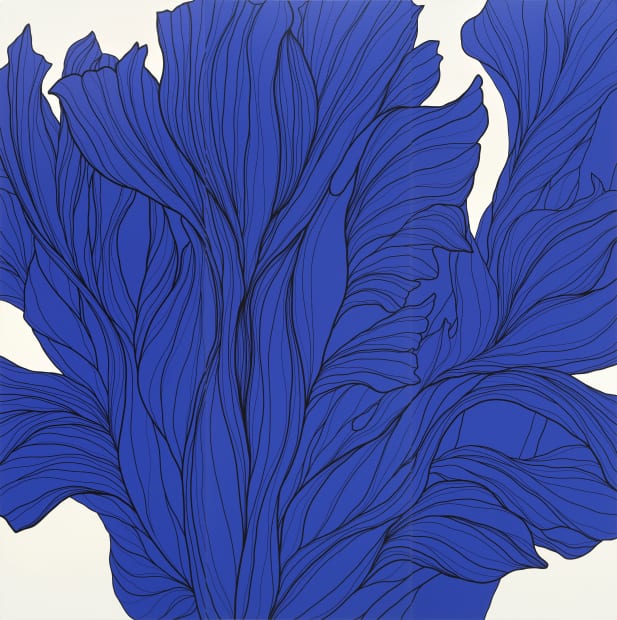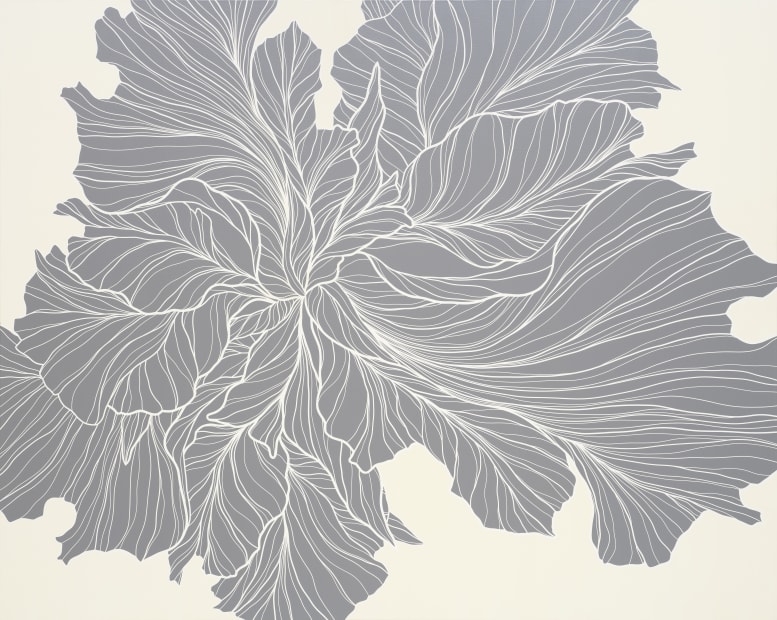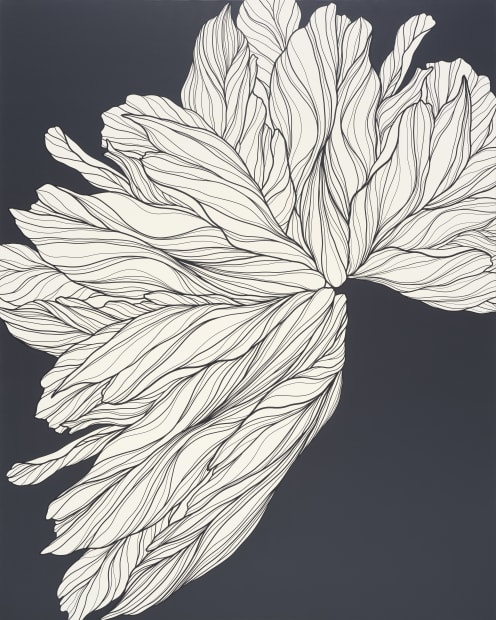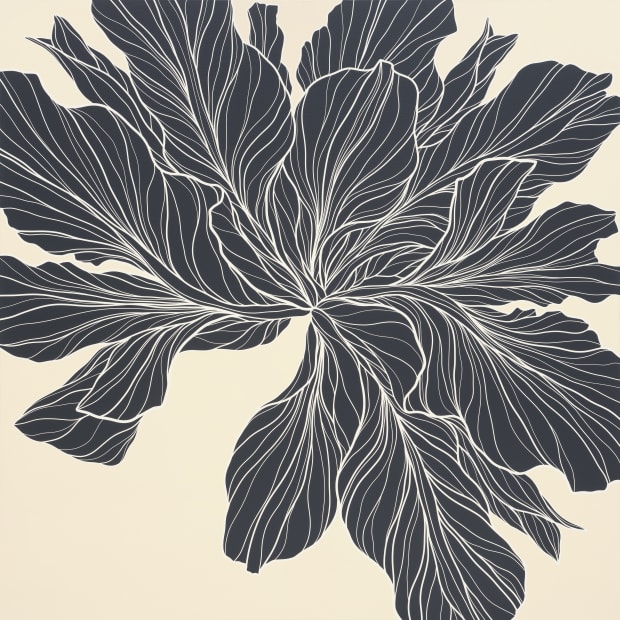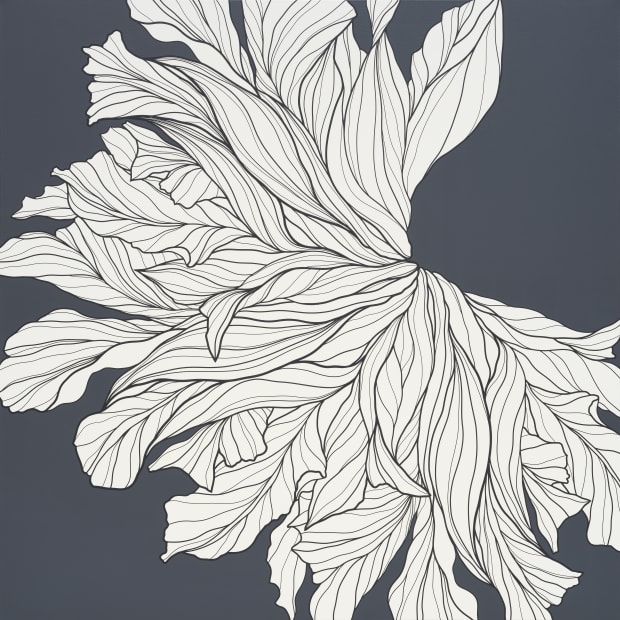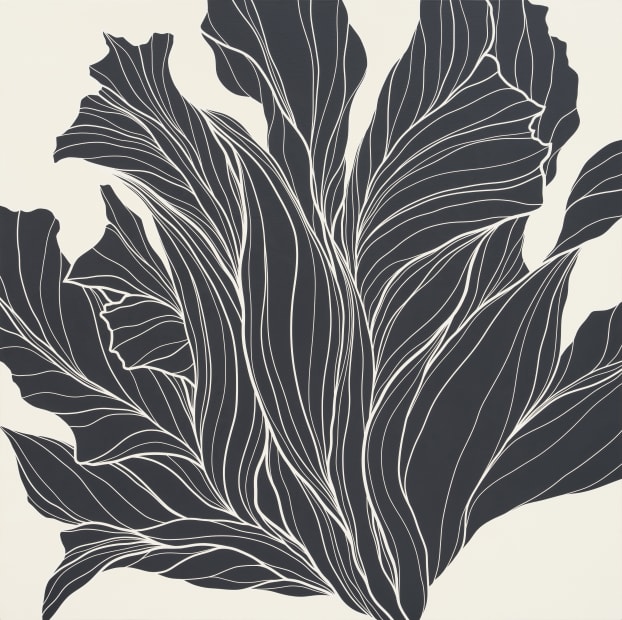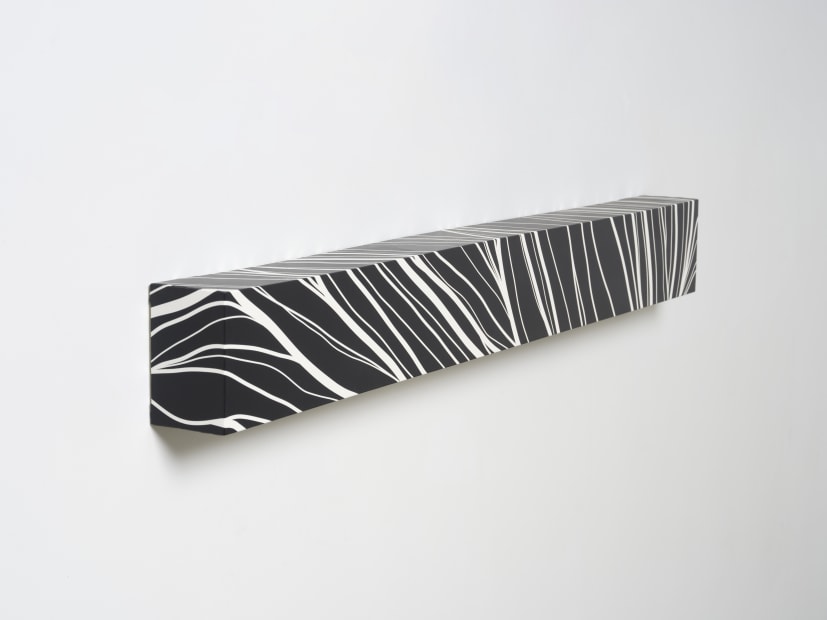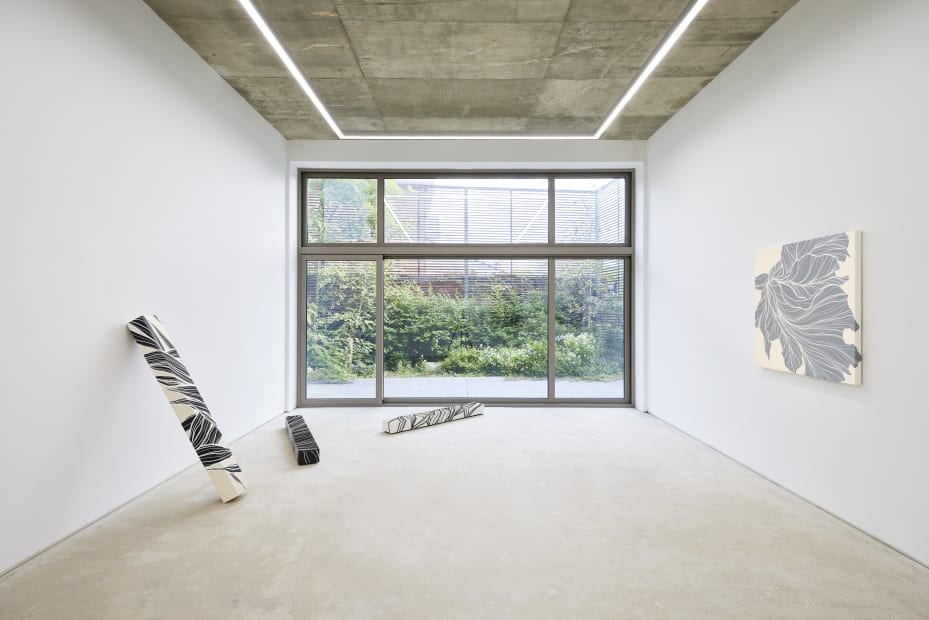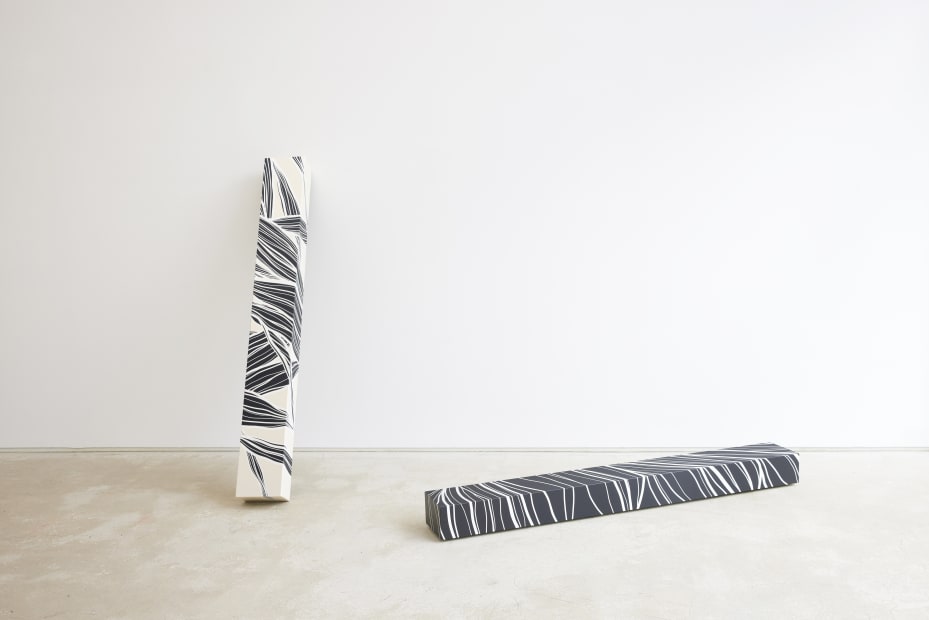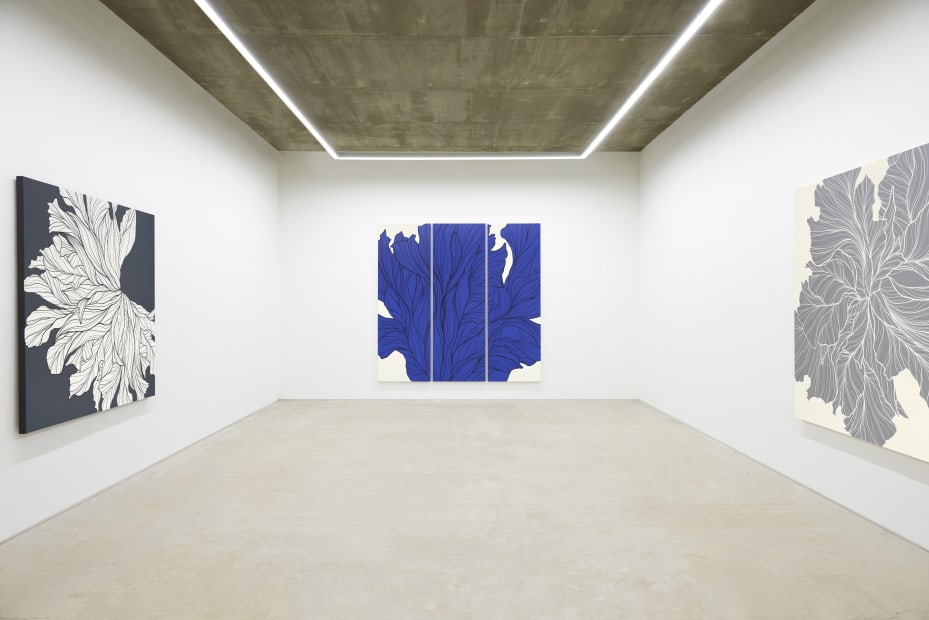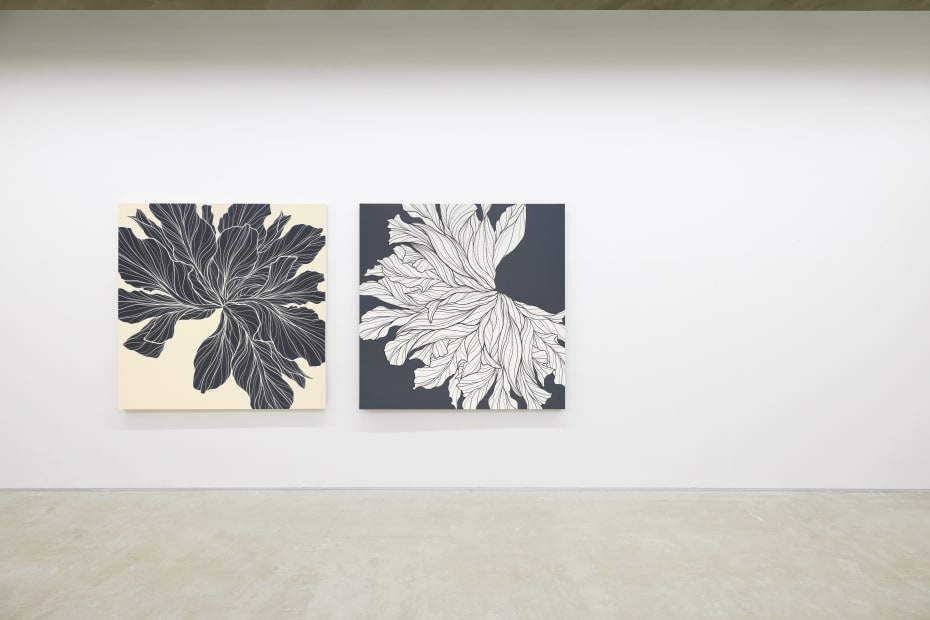하상림 Ha Sang Rim
하상림의 작업은 주변의 꽃과 식물을 관찰하는 것에서부터 시작한다. 이른 봄 추위를 무릅쓰고 가장 먼저 꽃을 피우는 매화는 그에게 생명의 경이로움과 순환하며 회귀하는 세상의 질서를 상기시켰다. 인간은 오래전부터 씨앗, 뿌리, 잎사귀, 줄기, 꽃을 보며 형태의 근원과 삶의 이치를 배워왔다. 식물과 인간의 외형적인 차이 너머에 존재하는 생명의 근원적인 동일성에 주목하는 것. 이는 식물성 안에서 인간의 삶을 발견하는 것이다.
작가는 매화를 보다가 똑같은 구조의 꽃잎이 원심형으로 구성되어 있다는 것을 발견한다. 이번 신작은 마치 꽃의 구조와 같이, 한 화면에 하나의 모티프(원형의 이미지)가 반복적으로 등장한다. 손으로 여러 번 수정하며 완성한 모티프를 캔버스 화면에 구성하고 모티프의 선을 따라 라인 테이프를 붙인다. 그리고 바탕이 되는 면과 모티프의 선을 단색으로 채색한다. 라인 테이프는 작가가 예전부터 추구해 온 가늘고 명료한 선을 만들어 낸다.
라인 테이프를 사용한다는 점은 식물의 잎사귀를 묘사했던 이전 작업과 연결된다. 이전 작업에서 하상림은 자신이 직접 찍은 식물 사진을 있는 그대로 재현했었다. 이는 자신의 ‘선’을 더하지 않고 자연에서 배운 ‘선’을 따르겠다는 그의 겸허한 태도가 담겨 있었기 때문이다. 그에 반해 이번 신작에 등장하는 선은 실물이 아닌 작가의 심상에서 발현된 것이다. 그의 몸에서 뽑혀져 나와 화면을 유영하는 선은 정녕 춤과 같이 시선을 끌어들이는 듯한 굴곡진 곡선이다.
사실 미술은 선에서 시작했다. 선사시대 사람들은 이미 그것을 이용할 줄 알았다. 대상을 화면에 옮겨 낼 때, 중단이나 충돌이 없이 이어지는 곡선의 운용을 통해 그들도 즐거움을 느꼈을 것이다. 여기서 작가가 왜 유독 자연을 관찰하는지 알 수 있다. 그가 그토록 표현하고 싶었던 선은 이미 자연에 존재하기 때문이다. 그 곡선은 식물의 외형뿐만 아니라 혈관과 같이 퍼져있는 잎맥에서도 찾아볼 수 있다. 이번 신작은 마치 꽃잎의 잎맥을 쫓아가듯 유연하지만 단순 명료한 곡선으로 표현했다. 그의 그림은 세부적인 묘사나 장식성을 배제하고 물과 양분을 수송하는 식물의 생명 길인 잎맥의 선을 전면에 부각시킨다. 이것은 식물의 외형이나 특수성을 강조하는 것이 아니라 대상을 단순화해서 그 대상의 본질을 묘사하고자 하는 것이다. 그 본질이란 생을 부여 받은 모든 존재는 자신이 속한 종(種)의 성장 법칙에 따라 성장과 소멸의 길을 따른다는 것이다. 이것은 인간도 다름이 없다.
결국 하상림의 그림은 꽃을 관찰하는 것에서 출발했지만 ‘꽃’이 아닌 ‘선’을 통해 생명의 경이로움으로 점철된다. 꽃은 자연의 일부, 식물의 종으로서 존재하는 것이 아니라 그로부터 멀리 벗어나 하나의 생명, 하나의 우주로 다가온다. 무한한 공간에 명료한 선으로 화면을 가득 채운 이 형상들은 특정한 꽃을 재현하는 것이 아닌 인간의 핏줄, 식물의 잎맥 등 모든 생명을 은유한다. 그리고 그 선은 도시의 길, 산의 능선처럼 또 다른 차원의 세계를 연상시키기도 한다.
이번 전시는 2012년 수풀 연작을 선보인 이후 10년 만에 새로운 작업을 소개하는 자리다. 그 사이 하상림은 여러 개인적인 일을 겪으면서 잠시 공백의 시간을 가졌다. 그는 이번 작업을 통해 다시 일상을 찾은 것 같았다고 말한다. 화가의 ‘일상’이란 타자를 관찰하고 그 안에 담긴 본질과 자신 사이의 교집합을 찾아내 형상을 부여하고 캔버스에 옮기는 일일 것이다. 작가는 자신 주변의 생명들과 자기 삶에서 유래한 모든 것들을 진솔하게 형상화한다. 나와 세상을 연결하고 함께 호흡하는 일. 이것이 화가의 일상이자 인간 삶의 본질이다.
Plants, often their flowers, catch the artist’s gaze. They inspire and inform her works. Plum blossoms welcome spring, bursting into a flourish of full bloom as if to celebrate the passing of what is gone and to welcome the coming of another season - a new life. For the artist, these blossoms were a reminder of life’s wonders and the circular and regressive order of this reality. Throughout history, humanity has observed looked to flora - the seeds, roots, leaves, stems, flowers and plant life - to learn the most fundamental shapes and forms, as well as broader truths that resonate with life beyond the self. Paying attention to the primordial identity of life, rooted unfathomably deeper than the distance of dissimilarity of the human and plant form. That was how she found humanity within the flora.
Ha Sang Rim was looking at plum blossoms when she noticed that the petals are arranged in a centrifugal manner. In her newest paintings, this centrifugal motif is repeated, conjuring the swirling centrifugal arrangement of flower petals. The sketch undergoes several adjustments by hand before the motif can be transposed unto the canvas, where the artist applies fine line tape along the lines. She then applies solid colors to the surface and the lines. She has long been painting with thin yet crisply clear lines, and the tape was taken up later as a useful tool.
Her use of tape comes from her previous works depicting plant leaves. In those works, Ha Sang Rim photographed plants and reproduced them as realistically as she could, on canvas. She had wanted to observe and learn nature’s way with lines, rather than painting lines based on her own way of lines. As the lines in her latest works are almost entirely freed from reference to photographs. Indeed, all lines are of her own doing, from what she felt inside. The line draws out from within her, the thin thready lines, swimming and dancing in a spectacle of no straight lines, like ink drips in water.
Drawing with lines was the most basic form of art. It is a most prototypal form. In fact, prehistory - time before written records - is in that form. Our prehistoric ancestors too, must have sensed the joy and even pleasure through the practice of lines on surface, trying to capture the essence of an object in a flowing and singular manner. Ha Sang Rim pored over nature and her designs for the prototypal forms and lines she sought to draw on canvas. Nature’s lines were not only found in the centrifugal arrangement of petals, but also in the furtive, fractally venated undersides of plant leaves. Ha’s latest works trail the venations of leaves and petals, naturally fluid and gentle, yet crisp and clear in contour. There is no elaboration, there is no flourish of blossom, yet there is the evenly balanced spread of life and nutriment across the entire surface. Lines drawn of flora on canvas are not of its outer beauty or of particular form. Rather, it is something of abstracted higher order, of its essence. What is life’s essence but the deepest groove, the surest of lines, the most iterated path of each and all species blessed with life? And with life, we too, are blessed by it.
These paintings are grounded in Ha Sang Rim’s observation of flower petals, but they are drawn in line and elevated to the wonder of life. Somewhere in between those fine lines, flowers gain meaning beyond a species within the flora. They expand into a splay of life, of a cosmos. Clear lines on infinite space form a venation of blossoms, of thriving human existence, and of all life. With enough imagination, the lines may inspire a photo-synesthesia of other dimensions, such as sprawling urban streets or aerial shots of a crested mountain range.
This solo exhibition by Ha Sang Rim is her first to present original works, in ten years. Her last solo presentation was in 2012, where she presented a series of paintings, untitled individually albeit under themes of groves and thickets. The past decade has been a welcome and necessary furlough, to attend to personal matters. These lines drew her back to normalcy, to a familiar daily routine, she says. Familiarity for the artist is to observe the other, to find a resonant frequency, to seek and recognize its essence through that resonance, and to provide it with tangible form upon the canvas. Familiarity is to connect with her neighboring lives and vitality, and to give form and embody what comes her from her own. To be a self, to connect with the other, the outside world, to respire with it. That is both the reality and metaphor of an artist, human life, and all living things.
